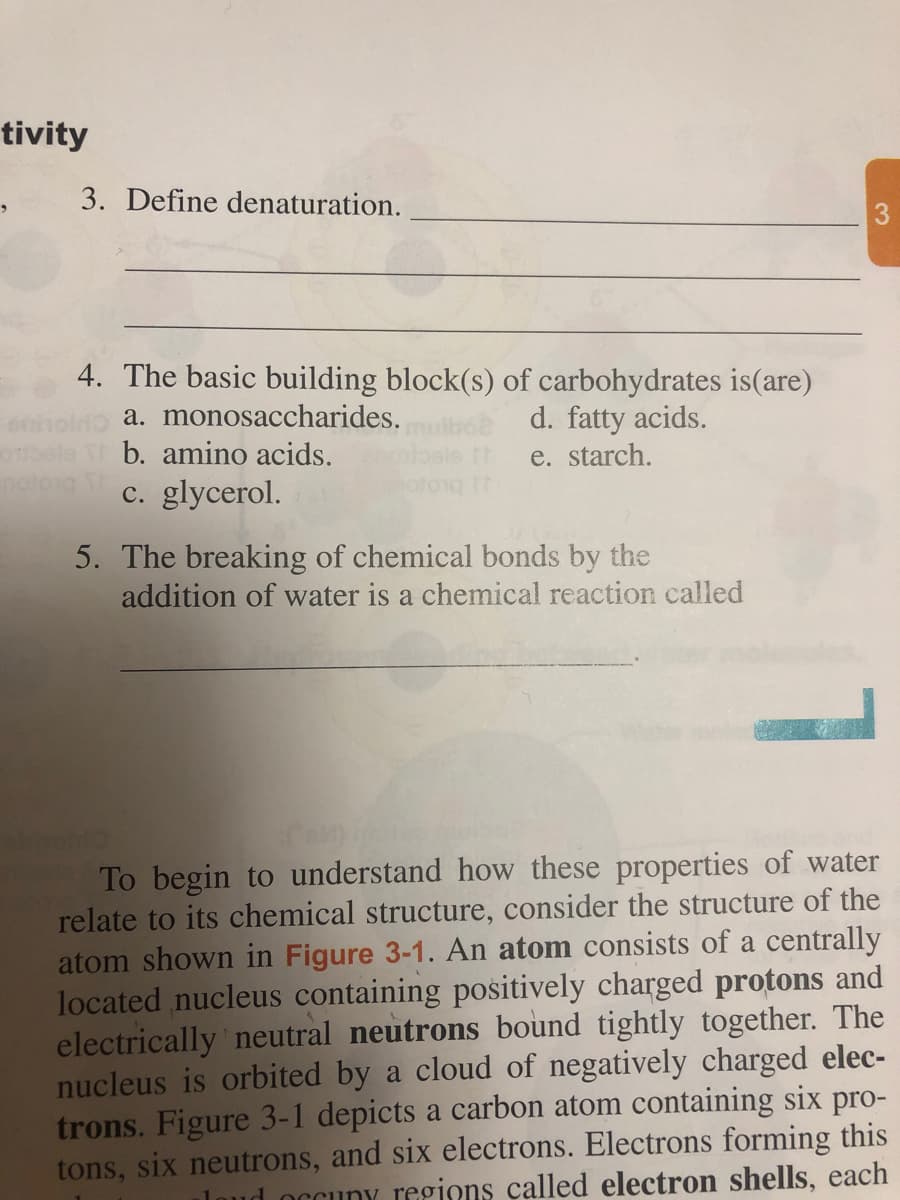3. Define denaturation. 3. 4. The basic building block(s) of carbohydrates is(are) a. monosaccharides. b. amino acids. d. fatty acids. e. starch. c. glycerol. 5. The breaking of chemical bonds by the addition of water is a chemical reaction called To begin to understand how these properties of water relate to its chemical structure, consider the structure of the atom shown in Figure 3-1. An atom consists of a centrally
3. Define denaturation. 3. 4. The basic building block(s) of carbohydrates is(are) a. monosaccharides. b. amino acids. d. fatty acids. e. starch. c. glycerol. 5. The breaking of chemical bonds by the addition of water is a chemical reaction called To begin to understand how these properties of water relate to its chemical structure, consider the structure of the atom shown in Figure 3-1. An atom consists of a centrally
Human Anatomy & Physiology (11th Edition)
11th Edition
ISBN:9780134580999
Author:Elaine N. Marieb, Katja N. Hoehn
Publisher:Elaine N. Marieb, Katja N. Hoehn
Chapter1: The Human Body: An Orientation
Section: Chapter Questions
Problem 1RQ: The correct sequence of levels forming the structural hierarchy is A. (a) organ, organ system,...
Related questions
Question
100%
Please help me solve question 3, 4, and 5.

Transcribed Image Text:tivity
3. Define denaturation.
3
4. The basic building block(s) of carbohydrates is(are)
a. monosaccharides.
b. amino acids.
d. fatty acids.
e. starch.
c. glycerol.
5. The breaking of chemical bonds by the
addition of water is a chemical reaction called
To begin to understand how these properties of water
relate to its chemical structure, consider the structure of the
atom shown in Figure 3-1. An atom consists of a centrally
located nucleus containing positively charged protons and
electrically neutral neutrons bound tightly together. The
nucleus is orbited by a cloud of negatively charged elec-
trons. Figure 3-1 depicts a carbon atom containing six pro-
tons, six neutrons, and six electrons. Electrons forming this
loud occuny regions called electron shells, each
Expert Solution
This question has been solved!
Explore an expertly crafted, step-by-step solution for a thorough understanding of key concepts.
Step by step
Solved in 4 steps with 4 images

Recommended textbooks for you

Human Anatomy & Physiology (11th Edition)
Anatomy and Physiology
ISBN:
9780134580999
Author:
Elaine N. Marieb, Katja N. Hoehn
Publisher:
PEARSON

Anatomy & Physiology
Anatomy and Physiology
ISBN:
9781259398629
Author:
McKinley, Michael P., O'loughlin, Valerie Dean, Bidle, Theresa Stouter
Publisher:
Mcgraw Hill Education,

Human Anatomy
Anatomy and Physiology
ISBN:
9780135168059
Author:
Marieb, Elaine Nicpon, Brady, Patricia, Mallatt, Jon
Publisher:
Pearson Education, Inc.,

Human Anatomy & Physiology (11th Edition)
Anatomy and Physiology
ISBN:
9780134580999
Author:
Elaine N. Marieb, Katja N. Hoehn
Publisher:
PEARSON

Anatomy & Physiology
Anatomy and Physiology
ISBN:
9781259398629
Author:
McKinley, Michael P., O'loughlin, Valerie Dean, Bidle, Theresa Stouter
Publisher:
Mcgraw Hill Education,

Human Anatomy
Anatomy and Physiology
ISBN:
9780135168059
Author:
Marieb, Elaine Nicpon, Brady, Patricia, Mallatt, Jon
Publisher:
Pearson Education, Inc.,

Anatomy & Physiology: An Integrative Approach
Anatomy and Physiology
ISBN:
9780078024283
Author:
Michael McKinley Dr., Valerie O'Loughlin, Theresa Bidle
Publisher:
McGraw-Hill Education

Human Anatomy & Physiology (Marieb, Human Anatomy…
Anatomy and Physiology
ISBN:
9780321927040
Author:
Elaine N. Marieb, Katja Hoehn
Publisher:
PEARSON